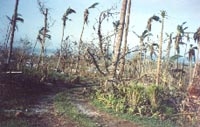Climate Research
Is there a role for indigenous knowledge in improving scientific understanding of future change in climate?
Penehuro F Lefale, NIWA

Long before the advent of complex numerical climate models, indigenous communities have used changes in their environments to predict changes in the climate and weather. Social and communal activities like feasting and fishing were planned in response to these changes (below table). Recent research by the National Institute of Water and Atmospheric Research (NIWA) aimed at documenting knowledge of climate and weather in Samoa revealed Samoans have their own unique seasonal calendar. Unlike the European calendar, which is based on astronomical events, the Samoan calendar is based on the observations of environmental changes, which are in turn largely influenced by the onset of extreme weather and climate events.
Scientists tend to assume that scientific problem-solving abilities are superior to those of traditional knowledge. However, the issues facing scientists today are becoming extremely complicated, often calling for more creative forms of collaboration between scientists and a broader range of disciplines and skills. In research into climate change, some of the most important tools being employed are numerical climate models. These models have evolved considerably over the years. The climate projections in the 2001 Intergovernment Panel on Climate Change Technical Assessment Report (IPCC TAR) draw on the output from climate models run for a range of plausible greenhouse gas scenarios. The best way to test a climate model is to run it for a period in the past using known greenhouse gas concentrations, and compare the output with past climate observations. This brings us to the importance of local observations, either in conventional data collection or in the documentation of indigenous knowledge.
Pacific Islands National Meteorological Services have been monitoring and collecting data from many parts of the South Pacific and continuing datasets that in some areas began over 100 years ago. Unfortunately, few parallel records have been kept of traditional perspectives on climate and weather. NIWA now recognises the important role of local climate and weather observations and knowledge. The project that resulted in documentation of the seasons from a Samoan perspective began in March 2001. Samoa, with its long history of climate data collection (1890) and local knowledge on predicting climate and weather events was the obvious place to start exploring these issues. NIWA hopes the project will be expanded to other Pacific Islands.
Samoan methods of climate and weather observations and possible Western scientifc equivalent
| Samoan Indicator/Phrase | English | Possible Scientific Tool Equivalent |
|---|---|---|
| Mogamoga | Cockroaches | Barometers |
| O le malio/kupa ma lona lua | The Hermit Crab | Anemometer |
| O le Atafa | Frigate Bird | Anemometer |
| Ua oso foi le gugu o le toeaina o le a sau le timu | The old man’s gout is back, rain is on the way | Barometer |
| Tulisi’a foi moa ua lata mai le timu its way | Chickens are running scared, rain is on | Anemometer Solarimeter Thermometer |
